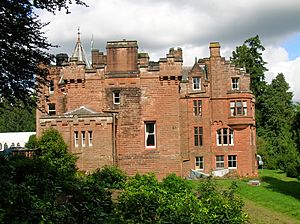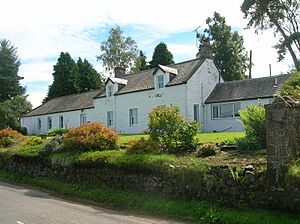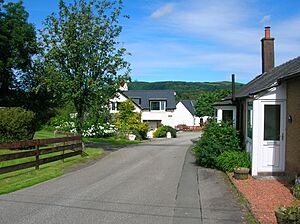Carse Loch facts for kids
Quick facts for kids Carse Loch |
|
|---|---|
| Lua error in Module:Location_map at line 420: attempt to index field 'wikibase' (a nil value). | |
| Location | Auldgirth, Dumfries and Galloway, Scotland |
| Type | Freshwater loch |
| Primary inflows | Laggan Burn (previously), Allanton Burn, Rainfall and runoff |
| Primary outflows | Mains Burn |
| Basin countries | Scotland |
| Max. length | circa 150 m (490 ft) |
| Max. width | circa 90 m (300 ft) |
| Islands | One crannog |
| Settlements | Auldgirth |
Carse Loch is a small freshwater loch in Dumfries and Galloway, Scotland. It's found in a low-lying area surrounded by trees, near the A76 road and Friars Carse. The loch is about 7 miles from Dumfries and 2 miles from Auldgirth. Long ago, monks used Carse Loch as a fish pond. People say these monks hid their treasures on the loch's island whenever there was danger.
Carse Loch's Past
In 1465, a special permission was given for monks from Melrose to build a monastery near Carse Loch. However, it seems they might have built a monastic farm, called a grange, instead. A grange was like a farm run by monks. You can still see names like Grange Mill and Grangeview nearby, which hint at this history.
The name 'Carse' comes from the Scots language. It means "low and fertile land next to a river or loch." This shows how important the loch was to the area.
Old maps help us understand how Carse Loch has changed. A map from 1747 shows it as 'Grange Loch' with a mill and one island. By 1855, it was still a good-sized loch with an island. There was also a corn mill nearby called Carse Mill. This mill used a special channel, or lade, to get water.
Over time, Carse Loch became much smaller. By 1899, it had shrunk a lot. In 1909, it was known as Friars' Carse Loch and was only about two to three acres in size. It used to get water from the Laggan Burn and another stream. But after the mill closed, the Laggan Burn no longer flowed into the loch. This greatly reduced its water supply.
The Crannog Mystery
There was a small island in Carse Loch that was once a crannog. A crannog is an ancient lake dwelling, like a house built on an artificial island in a loch. In 1878, this crannog was measured to be about 80 feet by 70 feet.
When people explored the crannog, they found old wooden timbers and traces of clay floors. They also discovered medieval pottery and a dug-out canoe (a boat made from a hollowed-out tree trunk) with a paddle.
As mentioned before, people believed the monks hid their treasures on this crannog. This was especially true during times of war or raids from England. An old axe hammer was also found on the crannog.
Today, Carse Loch is much smaller because of drainage. It's now mostly a marshy area within the Stottpark woodlands. The original crannog is said to have collapsed into the water in 1879 after it was studied. Even so, some modern maps still show one or two small islands in the area.
Carse Mills
The corn mill, or miln in Scots, near Carse Loch was still working in 1909. It got its power from the Laggan Burn. The mill had two holding ponds and a dam to control the water. Old maps show that the water from the mill's channel used to flow into the Mains Burn. But by the 1890s, it went directly into the partly drained loch. The Mains Burn then flows into the River Nith.
In the 1800s, there was also a smithy (a place where a blacksmith works) and a small school near Grangeview. Another mill building was shown in 1855 at Carse Mains Farm. This mill also had a small pond and a dam. By 1899, that millpond was drained.
Interesting Facts
In 1879, some beautiful Roman paterae (drinking bowls) were found near Friars Carse. This happened while a new road was being built.
Around 1909, people thought the Laggan Burn could be used to make electricity. This would have been done with a hydroelectric power plant.
The burial ground at Dunscore Old Kirk has memorials for the Ireland and Fergusson families, who lived at Carse Mill.




